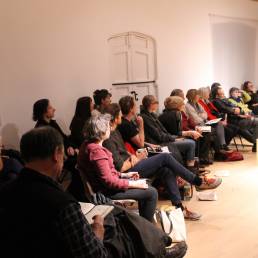
Subodh Gupta was born in 1964 in Khagaul, Bihar, India. His collection of sculptures and installations for the Hauser & Wirth exhibition, ‘Invisible Reality’, combines his love for art and cooking, using old and everyday objects relating to his home country.
The exhibitions title ‘ Invisible Reality’, links very closely to the collections centrepiece of the traditional wood and terracotta house from Southern India. As you walk around the installation you are drawn towards the doorway, which is intensely lit with a bright LED light. This makes it difficult and even impossible to glance inside and around the doorway of the house, as though the hidden content inside might have well have been invisible.
Another feature of this installation is the loud booming sound that vibrates through out the room every 5 or so minutes. The theme of sound, or moreover the need for sound, is present in many of the works throughout the exhibition. In their normal environment, the pots and pans are recognised for their loud clanging noise when bashed together, however, the pots and pans used in many of the sculptures are placed and hung so silently, that there is an overwhelming urge to bash them together when walking around this unusually still and quiet exhibition.
One of the pieces ‘Chanda Mama Door Ke’ had a kind of 2-sided perspective to it, in which as you walked about the sculpture it could been seen in a completely new form, from different angles. The sculpture ‘Chanda Mama Door Ke’ consisting of hundreds of cascading used utensils, pots and pans, appeared very light and still as it hung suspended from individually tied lengths of fishing wire, almost seeming in contrast to the usual heavy structure of these everyday utensils. Moving further away from the sculpture and viewing it as a whole it is clear to see that the individual utensils form one enormous cooking pot.
Another one of the sculptures that I felt had this 2-sided perspective was ‘ Specimen No.108’, the giant metallic tree in the grounds outside the gallery. It was one of the first sculptures I encountered as I arrived at the Gallery, and it was not until close up that I could identify the obscure-looking, silver ‘leaves’ as shiny, new, silver pots and pans. From far away it is possibly quite hard to tell what the ‘leaves’ are, however, when viewed from close up, this detailed and intricate sculpture suddenly appears very magnificent and grand.
Throughout the exhibition, it is clear to see that Gupta’s creations are linked closely for his passion in cooking and food. The theme of using old and used utensils such as pots and pan flows through the exhibition.
Ella Kearvall
